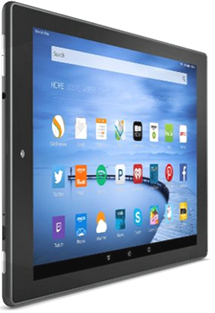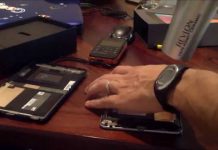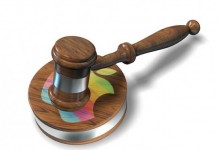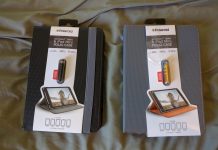 The big spotlight is on Amazon’s $50 seven-inch Fire tablet. As TeleRead Editor Chris Meadows has noted, it’s a good buy for the money. You get a screen resolution (1024 by 600) kind of par with, say, an old Nexus 7 (1280 by 800).
The big spotlight is on Amazon’s $50 seven-inch Fire tablet. As TeleRead Editor Chris Meadows has noted, it’s a good buy for the money. You get a screen resolution (1024 by 600) kind of par with, say, an old Nexus 7 (1280 by 800).
So what kinds of values might Amazon’s eight-inch tablet ($149.99) and ten-incher ($229.99 – shown in photo) offer for e-book-lovers? Amazon is releasing the tablets tomorrow, so it’s a timely question.
If you don’t want to tie yourself so closely to the Amazon ecosystem for e-books and items, you probably could do better elsewhere. And even without that qualification, Fortune has panned the Fire HD 10, the ten incher, calling it “a rare misfire for the company” due to a less-than-stellar screen and sluggish performance. “Books, magazines, Web pages, and the like all exhibit a noticeable fuzziness.”
Other review are less critical, but still far from absolutely gung ho.
The eight incher, notes the NextWeb, offers 189 pixels per inch. The ten incher is a mere 149 ppi. By comparison, the original iPads were 132 ppi, not that much less.
As described by NextWeb reviewer Lauren Hockenson, the tablets handle your Amazon book library like a champ,” with easy syncing between devices. “If you’re a bookworm, the HD 8 is probably a better device for you,” she writes, “since it is more portable. However, I did experience a little screen discoloration on the HD 8 versus reading on the HD 10.”
She notes the aspect ratio of the screens, 16:10, optimized for movies in landscape. In portrait mode, this could be good ratio for some people for reading e-books.
Hockenson recommends the eigh -incher as the more desirable of the two for e-reading because of its compactness. But I can see the ten incher as a possibility for two-page views, perhaps of PDFs, as long as you can tolerate the fuzziness. If nothing else, remember that the eight incher actually packs more pixels per inch.
One pro for some is that the tablets come with Amazon’s Word Runner feature, which flashes one word at a time on the screen to facilitate speed reading. That isn’t my cup of tea—I agree with Hockenson that the experiences could be too jarring. But others may like it.
More negatively, without going to extra trouble, you will not be able to chose from the same wealth of e-reading apps that true Android machines offer. These tablets won’t work with the Google Play Store, at least not without considerable tweaking. You can find the wonderful Moon+ Reader Pro at the Amazon App Store. But then Amazon lets you use it only on regular Android machines, not on Fire tablets.
Battery life? At least so-so. Both the eight- and ten-incher are rated at eight hours, but NextWeb’s Lauren Hockenson found she could go several days between chargings (presumably not with the display on all the time).
Weight? Not bad. The 10 incher, at 15.2 ounces, is especially light for its size. Amazon bills the screen as “our largest display on our thinnest tablet.”
In the end, however, in rating the tablets overall, Hockenson correctly concludes that you could do better if you don’t want to remain within the Amazon ecosystem. For $198, for example, you could buy a Lenovo Tab 2 A10 with a 12 hour battery life (her figure) and a 10-inch display of 1900X1200 pixels. The Android won’t be the latest, the weight will be 1.1 pounds, a little heavier than the same-sized Fire, and you probably won’t get Amazon’s level of customer service, but for many the Lenovo could still be a good alternative.
Meanwhile, over at Laptop Magazine, Michael Prospero gives the ten-incher Fire a mere 2.5 out of five stars, among other thing penalizing the tablet for “lower-resolution display than competitors,” a cheap-feeling deign and “sluggish performance.” On the positive side, he opines: “Fire OS 5 aids content discovery; Good parental controls; Mayday customer support; Expandable storage.”
“Amazon’s low-price 10-inch tablet,” he sums up, “makes it ever to find content, but it isn’t the bargain it seems.”
Related: Mashable’s less-than-fully-gung-ho review of the HD 10.































Some might want to do the sort of calculations I did when I was debating whether to buy an iPad 2 or, for what I recall as being $200 more, the just-out iPad 3.
Putting numbers to the decision made a big difference. Assuming just two years of use, that meant the added cost of an iPad 3 was $200/730 days or a little more than a 20 cents a day. That beautiful Retina display, I decided, was worth at least that.
I wasn’t happy when Apple gave the iPad 3 a short lifespan and brought out an iPad 4 with the much better Lightning connector. But my delight with that large Retina display more than compensated for that. I would have been much less happy with an iPad 2. And I’ve now been using that iPad 3 for 2.5 years and it’s still up-to-date enough to run the latest iOS without a hitch. Long term, that choice will probably cost me about a dime a day.
You might do something similar. Figure out how long you’re likely to use the tablets that interest you and convert that into a per-day cost. Paying an added $200 for an iPad or better-featured Samsung may sound like a lot in comparison to a low-end Kindle. But seeing that cost translated into per-day terms may change your mind.
——
If you don’t mind second hand, check out refurbished outlets such as:
http://www.a4c.com/tablets-ereaders.html
There is more than one page there. Just make sure that a discounted new model isn’t a better deal than an older, refurbished one.
You can also get a refurb iPad from Apple itself:
http://www.apple.com/shop/browse/home/specialdeals/ipad
A 15% discount isn’t a lot, but what you’re getting comes with a full Apple guarantee. The boxing isn’t as fancy though.
Samsung lists their refurb tablets here:
http://shop.us.samsung.com/store/samsung/en_US/list/ThemeID.38225500/categoryID.67795500
I’ve not bought from them before, so I know nothing more to say.
It’s only 50 bucks for bleep sake 😛 What do they expect? A fast machine with excellent screen??